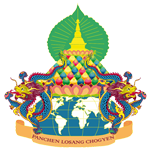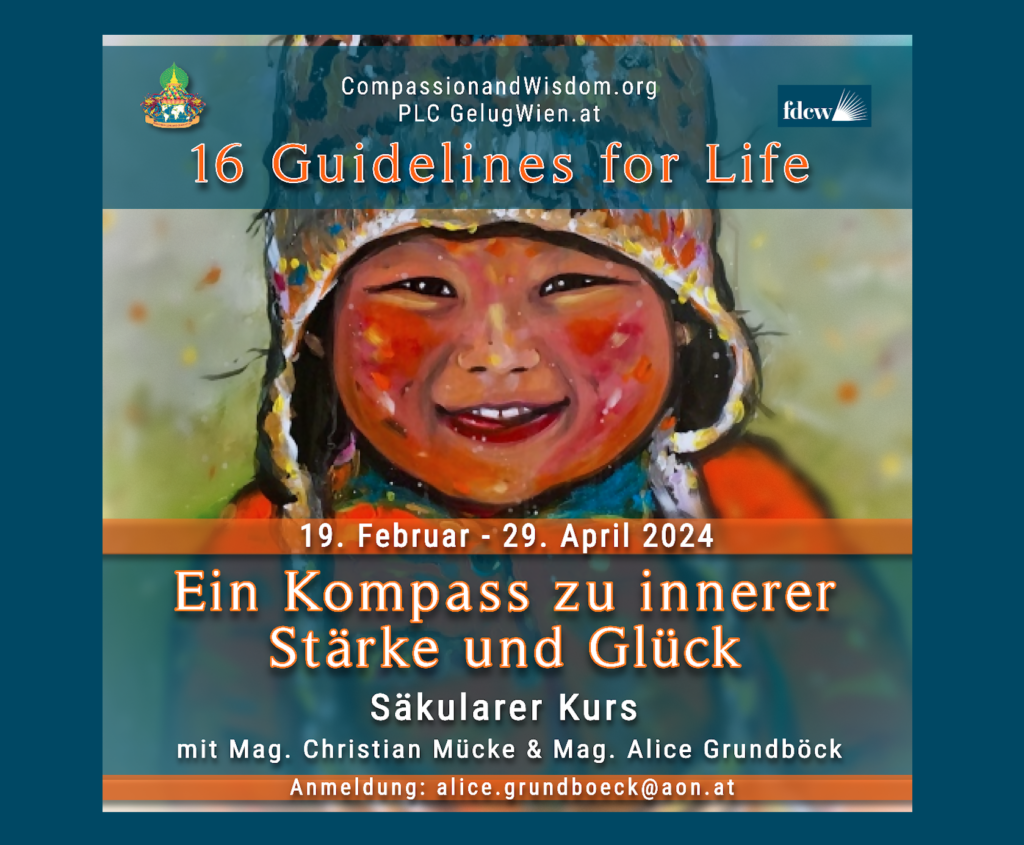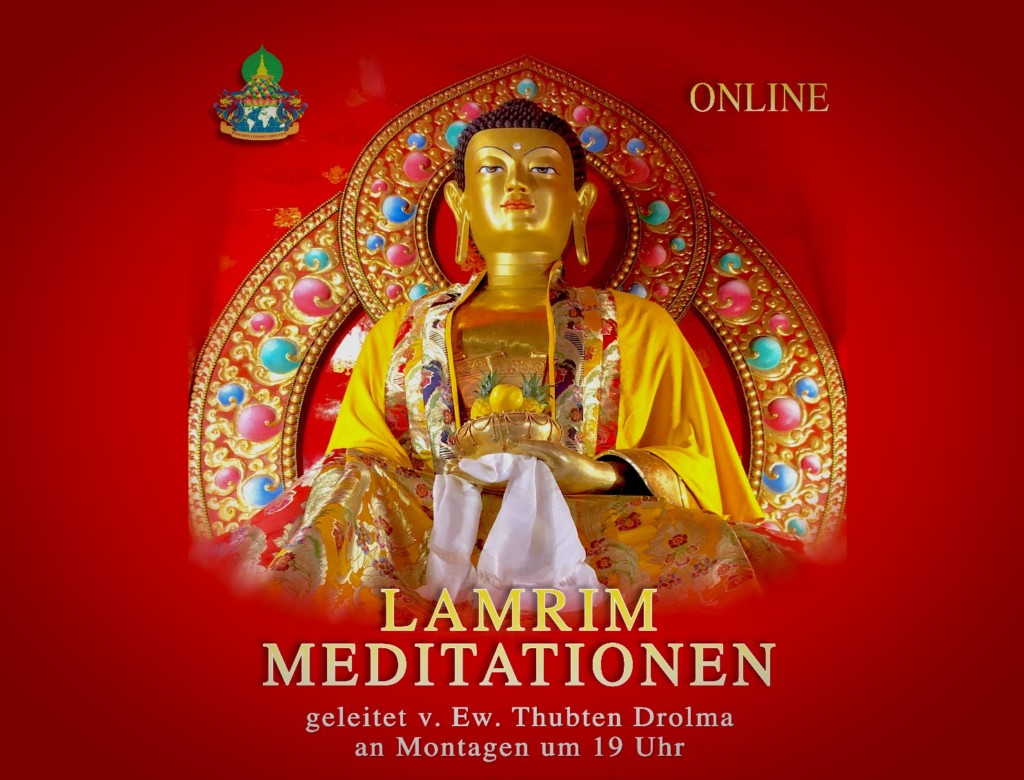
🙏🏼🌈 HE SERKONG TSENSHAB RINPOCHE Teaching & Retreat SEPT. 24
13. September - 22. September

SEPTEMBER 2024
His Eminence🙏🏼 🌈 SERKONG TSENSHAB RINPOCHE @ PLC Vienna:
- 13th of Sept. 2024: Teachings @ PLC Vienna (can be booked separately);
- 15th – 22nd of Sept. 2024: Unique!! RETREAT IN THE FORESTS & MOUNTAINS: ‘AS BUDDHA SHAKYAMUNI INTENDED’, at a beautiful Retreat-Center Kalapa in Southern Styria in the alps of Austria;
- Pre-registration and / or be informed when there is news: Here
- GERMAN VERSION HERE
We are very happy that the great master
HIS EMINENCE
SERKONG TSENSHAB RINPOCHE
has accepted our warm invitation with pleasure and will visit and teach us in September 2024!

His Eminence Serkong T. Rinpoche will give a teaching at our center ‘PLC’ in Vienna/Austria and on Rinpoche’s recommendation we will have the extraordinary and rare opportunity to spend a retreat together with Rinpoche in nature:
FROM TODAY’S POINT OF VIEW THE FOLLOWING PROGRAM IS PLANNED: SAVE THE DATES !
- 13. Sept. 2024: TEACHINGS / HE SERKONG TSENSHAB RINPOCHE at the PLC/Vienna: Heartfelt getting to know & teaching – more information to follow (teaching can be booked separately);
- Sept. 15-22, 2024: RETREAT IN THE FORESTS & MOUNTAINS: ‘AS BUDDHA SHAKYAMUNI RECOMMENDED’, at a beautiful Meditation-Center (Dzokden Kalapa Retreat Center) in the middle of nature in Southern Styria. Rinpoche is expected to teach Nagarjuna’s Fundamental Wisdom (or similar) and we will then deepen this in meditations together;
- We are looking forward to your pre-registration for the retreat, only a limited number of about 55 people can participate – please register anytime: Pre-Registration
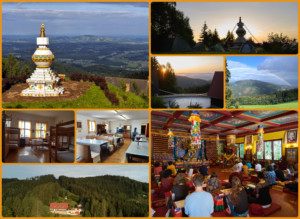
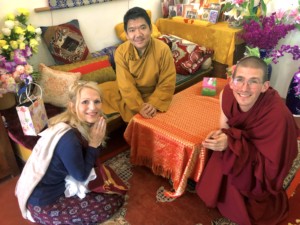 Ven. Thubten Wangdu (formerly Renato) and Christine had the wonderful opportunity to personally invite Serkong Tsenshab Rinpoche to Vienna Austria (during Saka Dawa 23 in Tushita Meditation Center in Dharamsala).
Ven. Thubten Wangdu (formerly Renato) and Christine had the wonderful opportunity to personally invite Serkong Tsenshab Rinpoche to Vienna Austria (during Saka Dawa 23 in Tushita Meditation Center in Dharamsala).
His Eminence was very happy and had the idea that it would be very auspicious to do a retreat in the forests and mountains in Austria as Buddha intended. Rinpoche told that His first stay in Europe was in Graz, when he was also invited during His Holiness Dalai Lama’s visit to Austria, told about his so positive memories of that time and was very pleased to receive our invitation!
We are very much looking forward to this special visit in SEPTEMBER 2024 of HE Serkong Tsenshab Rinpoche, to His wonderful teachings, personal retreat in a small circle (about 55 people) and possibly also an initiation is planned. More information of the program will follow soon.
We are already organizing everything in the best possible way: Teachings in PLC Vienna (especially also for those who cannot attend the retreat) and the mountain-retreat, as Rinpoche wished!
We are looking forward to your support and early registration for both events. Please note that there will be about 100 people on site at the PLC and only 55 people for the retreat at the meditation center on the mountains. at a beautiful Meditation-Center (Kalapa) in the middle of nature in Southern Styria;
- Pre-registration and / or be informed when there is news: Here
All the best, your PLC Team!

His Eminence Serkong Tsenshab Rinpoche is a great and highly respected tantr. master and regularly gives teachings of the highest teachings of the Tibetan Buddhist philosophy of the ancient Nalanda masters, such as the great treatises of Lama Tsongkhapa, Nagarjuna or Chandrakirti and many more.
Rinpoche has the special ability to convey the difficult topics, such as those on Emptiness and Bodhicitta, in such a way that they are of the greatest benefit to beginners and advanced students alike! Rinpoche is also known for his loving humor and the quality of being very heart-opening:
VIDEOS, SERKONG TSENSHAB RINPOCHE
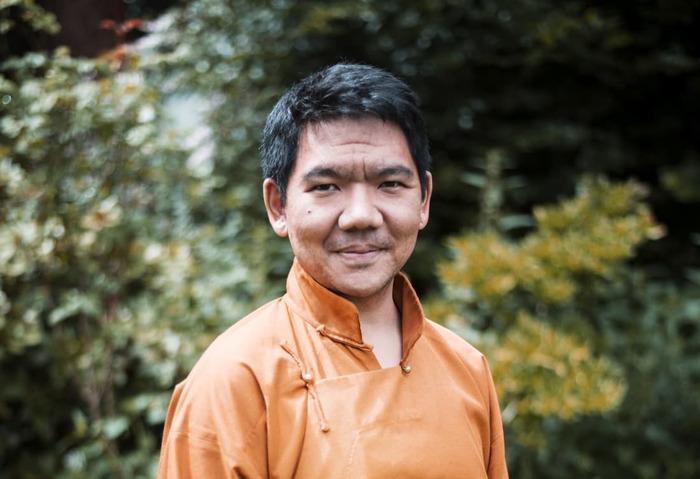
This is by no means the first meeting I’ve had with HE Serkong Rinpoche. In fact, my first encounter with him was back in 2008, when through my connection to Dr. Berzin, I got the chance to see him during my first visit to Dharamsala, the home of His Holiness the Dalai Lama. A relative newcomer to Buddhism at the time, it was rather nerve-wracking to meet someone who was recognized as the reincarnation of such a great teacher. I’d brought along a small Buddha statue for Rinpoche to bless, thinking he might unwrap it from its long silky kata to take a look and admire it, but disappointingly, he just said a few prayers and blew on it while it was still wrapped up, and that was that. But I soon came to realize that this was simply part of Rinpoche’s personality: exceptionally down-to-earth and very, very humorous. And with us being born just weeks apart, we also shared that generational connection: a love for technology and gadgets, as well as horror movies!
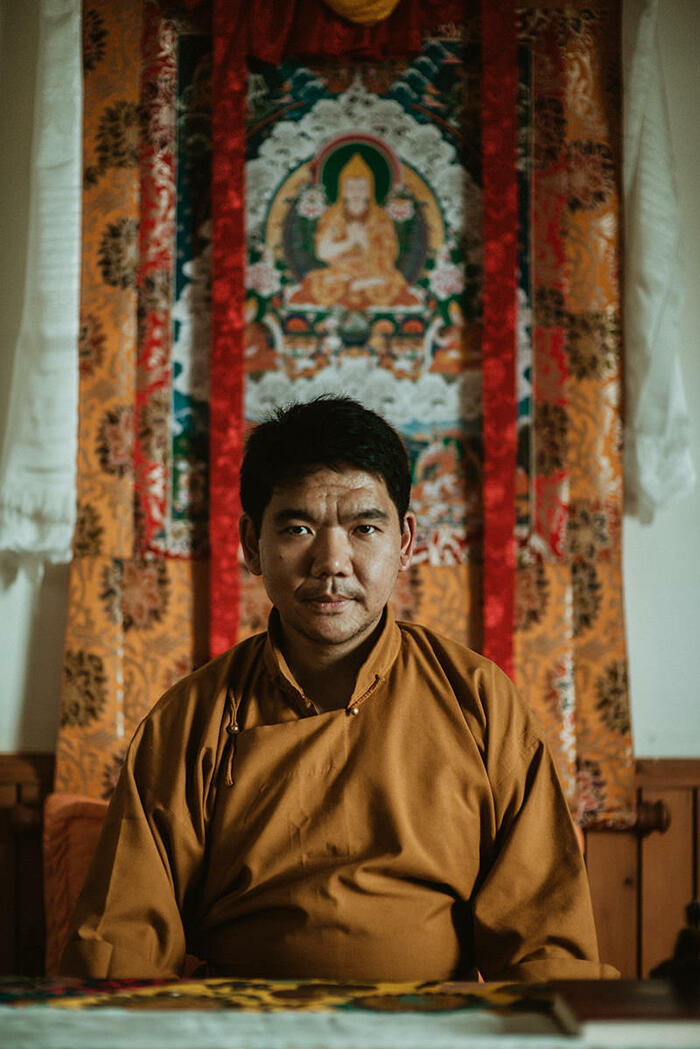
HE Serkong Rinpoche at his home in McLeod Ganj, northern India, 2018.
Born in 1984 to a large traditional family in the high-altitude region of Spiti, northern India, he was recognized at the age of three and a half as the reincarnation of Tsenshap Serkong Rinpoche, one of the 20th-century’s most highly-regarded Buddhist teachers and the debate partner of His Holiness the 14th Dalai Lama. In this interview, I talk with Serkong Rinpoche about the Tibetan tulku system, how we can maintain compassion in this day and age of extreme polarization and tackle the perennial question: what is the meaning of life?
Study Buddhism: I can imagine that there’s some kind of pressure that comes with being recognized as the reincarnation of such an eminent teacher. What kind of responsibilities does this give you, and do you feel like you’re the same person as the previous one?
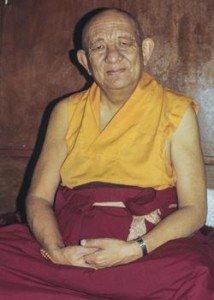 HE Tsenshab Serkong Rinpoche 1913-1984
HE Tsenshab Serkong Rinpoche 1913-1984
HE Serkong Rinpoche: Oh, that’s very tricky to answer! Firstly, I never met the previous one. The form is different, and also the mind has some differences. Mostly, I can say I don’t feel like him. The way he practiced, the amount of gurudevotion he had – I really admire him when I hear of his good qualities. However, I do feel very connected to the responsibilities of Serkong Tsenshap Rinpoche to benefit people. Sometimes I think, “Whether I’m the reincarnation or not, I have this great opportunity.” So I feel very lucky to have this opportunity.
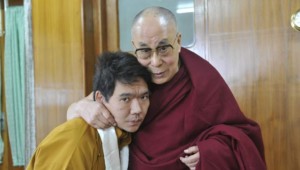 with His Holiness Dalai Lama
with His Holiness Dalai Lama
One of the most amazing things the previous Serkong Rinpoche did was to serve His Holiness the Dalai Lama. Also, due to his compassion towards the people of Spiti, he made tremendous connections with them, as well as Tibetans and some Westerners in Europe and America. I have the same wish to serve His Holiness. The task is a little different of course, because my predecessor was a qualified teacher, and I’m nowhere near that. I still have studies and practices to do. But, with the guidance of His Holiness, I will try my best to do whatever he wishes for me to do. On top of this, to continue what my predecessor has done before me, there are so many people who wish for me to teach them and to make karmic connections with me. So I feel like I should do this for them.
You were recognized at the age of three and a half and had to leave your family, including all of your brothers and sisters, to go and live in a monastery. At that age you can’t really make any decisions by yourself, so you were basically put into that situation. The question here is then, with Tibet’s tulku system, how useful is it and is it sustainable into the future?
Well, in the past, it was very helpful and, in the current situation, I believe it’s still helpful. The best example is His Holiness the Fourteenth Dalai Lama himself. He’s the fourteenth in the line of reincarnations, so up to now we’ve had great masters like him. I think that’s been very helpful.
But then now, you see, there should be some kind of limit, otherwise there will just be so many reincarnations. Because what we need are the best ones, and it’s really hard to choose which ones will be best, and which will be very successful. The monasteries have even had big discussions about this. That’s why sometimes His Holiness likes to make a distinction between lamas and tulkus. What’s the difference? He says there are people who could be both, but there are also people who are reincarnations – tulkus – but not lamas at all. We could say something like a “naughty tulku!” There can be a tulku who isn’t a lama, because a lama is someone who is qualified.
So while the tulku system is very important and has played a strong role in Tibetan Buddhism, it can also lead to some dangerous situations. A qualified lama would never ever even try a little bit to destroy people’s faith, because faith is everything. Faith is the basis of people’s connection to Buddhism, so there is a big danger here.
And as to whether the tulku system remains in the future, whether there should be the tulku system or not, I am nobody to decide yes or no!
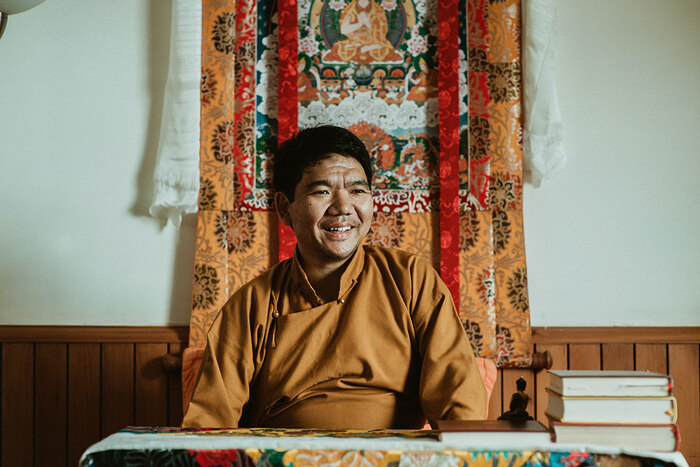
Of course, one of the key benefits of being recognized at such a young age is that you have access to the best teachers in the Buddhist world and have the chance to absorb the teachings in a way most Westerners can only dream of. For those of us starting later in life, what can we gain from studying the Buddhist teachings?
Buddhism has so many methods and beautiful teachings that help to remove our suffering! This is something that material goods and money can’t buy. Once you start to feel like you want to get out of what we call samsara – which refers to all of our suffering and problems – then the question can come as to whether one should study. But that’s very individual and it’s up to each person’s own interest. His Holiness the Dalai Lama always says that there is Buddhist religion, Buddhist philosophy, and Buddhist science. So there are many different things that can benefit different people.
For instance, compassion. Buddhists talk about it a lot, but just practicing compassion doesn’t make you a Buddhist. However, to generate compassion really well, we can all study Buddhist methods. You can improve your compassion like that. I don’t think there is anyone who doesn’t want to improve their compassion, because it’s such a beautiful thing, isn’t it?
So in general, there are many great qualities that we can gain from studying Buddhism, without the need to become a Buddhist. And the practices help us to train our mind and to fight against the obstacles that we are facing.
You just mentioned that we face obstacles. What do you mean by that? And then once we’ve worked out what they are, how do we start to study and practice Buddhism to overcome them?
Obstacles can be very small things, like being too distracted by our cellphones. Sometimes we forget about the people around us. Like in my family, when we talk and then my brothers and sisters come with their cellphones, my parents always try and have a conversation with us but my brothers and sisters are always busy. I can see the sadness and the loneliness, that even though the physical body is here, mentally we are disconnected.
I think a good place to start is by studying the Nalanda masters and the logic they used. In the West, people are already well-educated and modern people are so bright, but there might be lots of ego maybe. For some people, not all! But it’s very good to challenge yourself with this stuff.
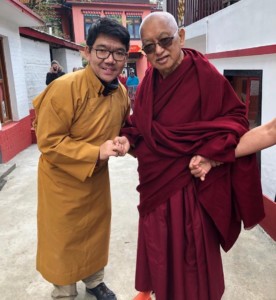
The Tibetan Buddhist tradition really pushes the lam-rim style, which talks about guru devotion and past and future lives, death, impermanence, all of these things. Atisha, the Nalanda master, checked how Tibetan people’s minds worked, and therefore this lam-rim style is really made for Tibetans.
For Westerners, I think it should be based on how the Nalanda masters tried to carry out their dialogues – how they had their views and would pose questions and get and give answers. They debated. All of this is very interesting, and I think this Nalanda style is a much safer approach to Buddhism.
Debate does play a huge role, especially in Tibetan Buddhism, as a way to gain conviction in the teachings. And one of the key features of Buddhism is that we are expected to question things – even central tenets. We can take rebirth as an example of something that a lot of Westerners coming to Buddhism struggle with. What exactly is rebirth, and can we be Buddhists without believing in it?
It’s really confusing sometimes for many people, and for me too! After we die, we will leave this body and our consciousness will continue. And then we will take another form, and we use this form, as we say in Buddhism, like a guesthouse. We come and go, we stay and go.
Buddhism isn’t only about past and future lives… Compassion, love for others, patience. All these kinds of beautiful practices, this is what Buddhism is really about.
If you don’t have so much knowledge about consciousness, about how consciousness works, then it’s a really difficult subject. If you are really interested, and then you learn and know a little bit about consciousness, and about how it works, then what rebirth is and whether there is rebirth or not, the answers will be very clear.
But can you practice Buddhist practices without believing in past and future lives? Definitely, sure. Buddhism isn’t only about past and future lives. Because when we look at the Four Noble Truths, it does not talk about past and future lives. This is the first teaching of Buddha, and his focus is on suffering. When you think about suffering, and you think about whether there’s a way to get rid of suffering, there are so many things: more

